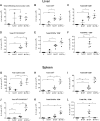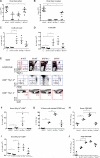Memory CD8⁺ T cells can outsource IFN-γ production but not cytolytic killing for antiviral protection
- PMID: 23684306
- PMCID: PMC3662238
- DOI: 10.1016/j.chom.2013.04.004
Memory CD8⁺ T cells can outsource IFN-γ production but not cytolytic killing for antiviral protection
Abstract
Immunization with vaccinia virus (VACV), the virus comprising the smallpox vaccine, induces memory CD8(+) T cells that protect from subsequent infections with smallpox in humans or the related ectromelia virus (ECTV) in mice. Memory CD8(+) T cells largely mediate these effects by expanding into secondary effectors that secrete the antiviral cytokine interferon-γ (IFN-γ) and induce cytolysis via releasing factors such as perforin, which permeabilizes target cells. We show that protection from ECTV infection after VACV immunization depends on the initial memory cell frequency and ability of expanded secondary effectors to kill infected targets in a perforin-dependent manner. Although IFN-γ is essential for antiviral protection, it can be produced by either secondary effectors or concomitant primary effector CD8(+) T cells recruited to the response. Thus, during lethal virus challenge, memory CD8(+) T cells are required for cytolytic killing of infected cells, but primary effectors can play important roles by producing IFN-γ.
Copyright © 2013 Elsevier Inc. All rights reserved.
Figures






Similar articles
-
CD4+ T cell help is dispensable for protective CD8+ T cell memory against mousepox virus following vaccinia virus immunization.J Virol. 2015 Jan;89(1):776-83. doi: 10.1128/JVI.02176-14. Epub 2014 Oct 29. J Virol. 2015. PMID: 25355885 Free PMC article.
-
Comparable polyfunctionality of ectromelia virus- and vaccinia virus-specific murine T cells despite markedly different in vivo replication and pathogenicity.J Virol. 2012 Jul;86(13):7298-309. doi: 10.1128/JVI.00038-12. Epub 2012 Apr 24. J Virol. 2012. PMID: 22532670 Free PMC article.
-
Gamma interferon and perforin control the strength, but not the hierarchy, of immunodominance of an antiviral CD8+ T cell response.J Virol. 2011 Dec;85(23):12578-84. doi: 10.1128/JVI.05334-11. Epub 2011 Sep 14. J Virol. 2011. PMID: 21917955 Free PMC article.
-
Is interferon-gamma the right marker for bacille Calmette-Guérin-induced immune protection? The missing link in our understanding of tuberculosis immunology.Clin Exp Immunol. 2012 Sep;169(3):213-9. doi: 10.1111/j.1365-2249.2012.04614.x. Clin Exp Immunol. 2012. PMID: 22861360 Free PMC article. Review.
-
Effects on Cells.In: Baron S, editor. Medical Microbiology. 4th edition. Galveston (TX): University of Texas Medical Branch at Galveston; 1996. Chapter 44. In: Baron S, editor. Medical Microbiology. 4th edition. Galveston (TX): University of Texas Medical Branch at Galveston; 1996. Chapter 44. PMID: 21413282 Free Books & Documents. Review.
Cited by
-
Loss of Resistance to Mousepox during Chronic Lymphocytic Choriomeningitis Virus Infection Is Associated with Impaired T-Cell Responses and Can Be Rescued by Immunization.J Virol. 2020 Feb 14;94(5):e01832-19. doi: 10.1128/JVI.01832-19. Print 2020 Feb 14. J Virol. 2020. PMID: 31826990 Free PMC article.
-
Rapid expansion of CD8+ T cells in wild-type and type I interferon receptor-deficient mice correlates with protection after low-dose emergency immunization with modified vaccinia virus Ankara.J Virol. 2014 Sep;88(18):10946-57. doi: 10.1128/JVI.00945-14. Epub 2014 Jul 9. J Virol. 2014. PMID: 25008931 Free PMC article.
-
Resistance To Poxvirus Lethality Does Not Require the Necroptosis Proteins RIPK3 or MLKL.J Virol. 2023 Feb 28;97(2):e0194522. doi: 10.1128/jvi.01945-22. Epub 2023 Jan 18. J Virol. 2023. PMID: 36651749 Free PMC article.
-
Chronic Lymphocytic Choriomeningitis Infection Causes Susceptibility to Mousepox and Impairs Natural Killer Cell Maturation and Function.J Virol. 2020 Feb 14;94(5):e01831-19. doi: 10.1128/JVI.01831-19. Print 2020 Feb 14. J Virol. 2020. PMID: 31776282 Free PMC article.
-
Rational development of multicomponent mRNA vaccine candidates against mpox.Emerg Microbes Infect. 2023 Dec;12(1):2192815. doi: 10.1080/22221751.2023.2192815. Emerg Microbes Infect. 2023. PMID: 36947428 Free PMC article.
References
-
- Badovinac VP, Messingham KA, Hamilton SE, Harty JT. Regulation of CD8+ T cells undergoing primary and secondary responses to infection in the same host. J Immunol. 2003;170:4933–4942. - PubMed
-
- Betts MR, Brenchley JM, Price DA, De Rosa SC, Douek DC, Roederer M, Koup RA. Sensitive and viable identification of antigen-specific CD8+ T cells by a flow cytometric assay for degranulation. Journal of immunological methods. 2003;281:65–78. - PubMed
-
- Billiau A, Matthys P. Interferon-gamma: a historical perspective. Cytokine & growth factor reviews. 2009;20:97–113. - PubMed
-
- Cerwenka A, Lanier LL. Natural killer cells, viruses and cancer. Nature reviews. Immunology. 2001;1:41–49. - PubMed
Publication types
MeSH terms
Substances
Grants and funding
LinkOut - more resources
Full Text Sources
Other Literature Sources
Medical
Research Materials

